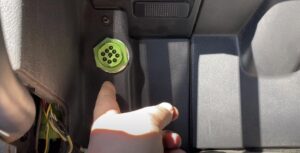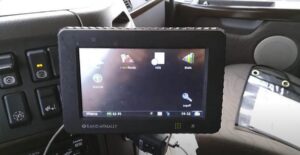
Have you ever found yourself on the road, the dashboard suddenly flashing a warning light about Diesel Exhaust Fluid (DEF)? It’s a common scenario for diesel vehicle owners, and one key question immediately springs to mind: “How far can I drive with the DEF light on?” This article delves into this crucial question, providing valuable insights and practical guidance.
Understanding the DEF System
Before tackling the main question, it’s essential to understand what the DEF system is and why it’s important.
What is DEF?
DEF, short for Diesel Exhaust Fluid, represents a transformative innovation in the realm of diesel engine technology. It is a precise blend consisting of urea and deionized water, meticulously engineered to serve as a potent weapon against the perilous scourge of nitrogen oxide (NOx) emissions. In modern diesel engines, DEF plays the role of a catalytic agent that orchestrates a chemical dance in the exhaust stream, reducing harmful emissions to a benign mixture of nitrogen and water vapor.
Composition of DEF:
- Urea: Urea, the organic compound at the heart of DEF, is a colorless, odorless, and non-toxic substance, which makes it an ideal candidate for emission reduction. It contains 32.5% nitrogen by weight, a critical element in the NOx reduction process;
- Deionized Water: The other primary component of DEF is deionized water. This type of water has had its ions, both positive and negative, removed through a process called deionization. The purity of deionized water is paramount, as any impurities could disrupt the chemical reactions within the DEF system.
How Does DEF Work?
Understanding the inner workings of DEF is pivotal to appreciating its role in emission reduction. The DEF system operates by introducing DEF fluid into the hot exhaust gases expelled from a diesel engine. This intricate process involves several key components:
- DEF Tank: The DEF tank, typically located adjacent to the fuel tank, serves as the reservoir for DEF fluid. It is equipped with a heating element to prevent freezing in cold climates.
- DEF Injector: A dedicated DEF injector sprays the DEF fluid directly into the exhaust stream in precise quantities. The rate of injection is meticulously controlled by the vehicle’s electronic control unit (ECU);
- Chemical Reactions: As DEF is vaporized in the hot exhaust gases, it undergoes a complex chemical transformation. The urea in DEF decomposes into ammonia (NH3) and carbon dioxide (CO2). Subsequently, the ammonia reacts with the nitrogen oxides (NOx) in the exhaust, breaking them down into harmless nitrogen (N2) and water vapor (H2O);
- SCR Catalyst: The Selective Catalytic Reduction (SCR) catalyst, positioned downstream in the exhaust system, facilitates the chemical reactions between DEF and NOx emissions, ensuring efficient reduction of harmful pollutants.
By comprehending this process, one can appreciate the pivotal role that DEF plays in reducing NOx emissions—a critical step toward achieving compliance with stringent environmental regulations and enhancing overall air quality.
The DEF Indicator Light: A Critical Alert Mechanism
In the context of diesel vehicles equipped with a DEF system, the DEF indicator light assumes significant importance. This indicator light is a pivotal component of the vehicle’s instrumentation panel and serves as an alert mechanism for the driver. Understanding its operation and significance is crucial for any diesel vehicle owner or operator:
- Low DEF Warning: When the DEF level in the tank becomes insufficient, the DEF indicator light will illuminate on the dashboard. This serves as a timely warning to the driver that it’s time to refill the DEF tank to ensure the continued operation of the emissions control system;
- Limited Engine Performance: In some vehicles, a low DEF level may trigger a reduction in engine performance. This is a safeguard mechanism to prevent the vehicle from operating without proper emission control;
- No Restart After Depletion: In certain situations, if the DEF tank becomes completely empty, the vehicle may not restart after being shut off. This is another measure to ensure compliance with emissions regulations and to encourage timely DEF refilling.
The Significance of DEF: Environmental Impact and Compliance
The significance of DEF extends far beyond the confines of a diesel engine’s components. It resonates with broader environmental and regulatory implications:
- Reducing Environmental Footprint: DEF enables diesel engines to significantly reduce their environmental footprint by curbing harmful nitrogen oxide emissions. This reduction directly contributes to cleaner air quality and a healthier environment;
- Emissions Regulations: In response to the pressing need for environmental protection, regulatory bodies like the Environmental Protection Agency (EPA) have established stringent emissions standards. DEF is a pivotal tool for diesel engine manufacturers to meet these stringent requirements, particularly the EPA’s Tier 4 standards.
Best Practices for DEF Maintenance and Usage
To conclude this extensive guide, it is essential to outline some best practices for DEF maintenance and usage:
- Quality DEF Fluid: Always use high-quality DEF fluid that meets the ISO 22241 standards. Using subpar DEF can compromise the efficiency of the DEF system;
- Proper Storage: Store DEF fluid in a cool, dry place, away from direct sunlight. Avoid contamination of the DEF fluid, as even small impurities can hinder its effectiveness;
- Regular Refilling: Monitor the DEF fluid level in the tank and respond promptly to the DEF indicator light. Timely refilling ensures uninterrupted operation and prevents engine performance degradation;
- Cold Weather Considerations: In cold climates, ensure that the DEF tank remains heated to prevent freezing. Use DEF heaters and maintain appropriate insulation.
How Far Can You Drive with DEF Light On?

Now, back to our primary concern: how far you can drive once that DEF light comes on. It’s a critical question, especially if you’re miles away from the nearest service station.
Factors Affecting Distance
Several key factors come into play when determining how far you can drive with the DEF light illuminated:
- Vehicle Model: Different diesel vehicles consume DEF at varying rates. The rate of DEF consumption is influenced by the vehicle’s engine size, emission control technology, and overall design. Some vehicles may have more efficient DEF utilization than others, allowing for longer distances with the DEF light on;
- Driving Conditions: The type of driving conditions you encounter can significantly impact DEF consumption. Highway driving typically results in more efficient DEF usage compared to stop-and-go city driving. This is because highway driving generally involves more consistent engine operation and exhaust system temperatures, leading to optimized DEF conversion;
- DEF Tank Capacity: The size of your vehicle’s DEF tank plays a crucial role in determining the distance you can cover with the DEF light on. Vehicles equipped with larger DEF tanks naturally have the capacity to cover more miles before needing a refill.
General Guidelines
While the specific distance you can travel with the DEF light on may vary depending on the factors mentioned above, there are some general guidelines to keep in mind:
- Initial Warning: When the DEF light first illuminates on your dashboard, it typically indicates that the DEF fluid level is getting low. At this stage, you can usually continue driving for approximately 10-20% of your average driving range. For example, if your vehicle typically covers 500 miles on a full tank of DEF, you can expect to travel an additional 50 to 100 miles after the light comes on. However, it’s essential not to push the limit too far to avoid running out of DEF completely;
- Reduced Performance Stage: In some diesel vehicles, as the DEF level continues to decrease, the engine may enter a reduced performance mode to conserve DEF. This is a protective measure to ensure that the vehicle complies with emissions regulations. During this stage, your vehicle’s performance may be limited, and it is highly advisable to seek DEF replenishment as soon as possible to avoid any potential inconvenience.
Table: Examples of DEF Tank Capacities
| Vehicle Model | DEF Tank Capacity (Gallons) |
| Compact Diesel Car | 2.5 |
| Midsize Diesel SUV | 4.0 |
| Heavy-Duty Diesel Truck | 10.0 |
| Commercial Bus | 15.0 |
These examples illustrate how DEF tank size can vary significantly between vehicle types, affecting the distance you can drive with the DEF light on.
Preventive Measures

When it comes to managing the Diesel Exhaust Fluid (DEF) system in your diesel vehicle, taking preventive measures is crucial to ensure you never find yourself in a situation where the DEF light catches you off-guard. Here are some detailed preventive measures to consider:
Regular Checks
- Routine DEF Level Checks: A fundamental and proactive measure is to regularly monitor your DEF fluid levels. This can be easily accomplished by referring to your vehicle’s DEF gauge on the dashboard or accessing the DEF level information through the vehicle’s information system. Pay special attention to DEF levels before embarking on long trips or journeys. Ensuring that your DEF tank is adequately filled prior to extended drives can preemptively prevent the need for an emergency DEF refill;
- Scheduled Maintenance: Incorporate DEF level checks into your vehicle’s scheduled maintenance routine. During routine service appointments, have your DEF system thoroughly inspected, and the fluid topped off as necessary. This practice not only maintains your DEF system’s efficiency but also ensures that you are always prepared for your next journey, whether it’s a short commute or a cross-country expedition.
Understanding Your Vehicle
- Know Your Vehicle’s DEF Consumption Pattern: Different diesel vehicles exhibit varying DEF consumption patterns. Understanding how your specific vehicle utilizes DEF is invaluable. You can find this information in your vehicle’s owner’s manual or by consulting with your vehicle manufacturer or dealer. Knowing your vehicle’s DEF consumption rate allows you to estimate how far you can travel before needing a refill once the DEF light comes on;
- Monitor DEF Usage: Some modern vehicles provide detailed information about DEF usage through the vehicle’s information system. Monitor this data regularly to gauge how quickly your vehicle consumes DEF under different driving conditions. This knowledge empowers you to plan ahead and schedule DEF refills more effectively;
- DEF Fluid Storage: Ensure proper storage of DEF fluid to maintain its quality. Store DEF in a cool, dry place, away from direct sunlight, and keep the container tightly sealed. Quality DEF is essential for efficient emissions reduction;
- Cold Weather Precautions: In regions with cold climates, take precautions to prevent DEF from freezing. DEF has a freezing point of approximately 12°F (-11°C). Ensure that your DEF tank is equipped with a heating element to keep the fluid from solidifying. Additionally, consider using DEF additives designed to lower the freezing point further;
- Use Approved DEF: Always use DEF that meets the ISO 22241 standards. Using non-compliant or low-quality DEF can adversely affect the performance of your DEF system and may lead to more frequent refills.
Conclusion
Understanding how far you can drive with the DEF light on is vital for diesel vehicle owners. While there’s some wiggle room once the light comes on, it’s crucial not to push your luck too far. Regular maintenance and awareness of your vehicle’s DEF needs can save you from potential trouble on the road.
Remember, when that DEF light flickers on, it’s not just a suggestion – it’s a call to action.
FAQ
Can I ignore the DEF warning light?
Ignoring it can lead to reduced engine performance or even a vehicle shutdown.
How often should I refill the DEF tank?
It depends on your vehicle and driving habits, but generally, it’s good to check every 5,000 miles.
Is it safe to drive with the DEF light on?
It’s safe for a short period, but it should be addressed as soon as possible.
Can I refill the DEF tank myself?
Yes, DEF is available at auto parts stores and service stations.





